|
|
|
|
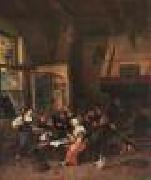 |
DUSART, Cornelis
|
|
Dutch Baroque Era Painter, 1660-1704
Dutch painter, draughtsman and printmaker. He was the son of the organist at St Bavo in Haarlem and one of the last pupils of Adriaen van Ostade. He became a member of the Haarlem Guild of St Luke on 10 January 1679 and served as its dean in 1692. Dated pictures by Dusart have survived from almost every year between 1679 and 1702. Two of his earliest pictures of peasants relied heavily on compositions by van Ostade: Mother and Child (1679; Dresden, Gemeldegal. Alte Meister) and Woman Selling Milk (1679; sold Amsterdam, Muller, 16 Oct 1928, lot 9; the original drawing by van Ostade is in Paris |
|
|
|
|
|
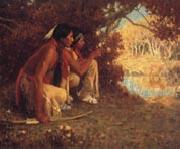 |
Eanger Irving Couse
|
|
American Painter , b.1866 d.1936
was an artist and founding member of the Taos artists colony in Taos, New Mexico. Couse was born in Saginaw, Michigan, where he first started drawing the Chippewa Indians who lived nearby. Couse attended the Art Institute of Chicago, and the National Academy of Design, New York. He left for Paris to study at the Ecole des Beaux-Arts and Academie Julian under Bouguereau. He lived in France 10 years, where he painted charming scenes of the Normandy coast. After his return to America he devoted himself to depicting the life and habits of the Taos Indians, a pueblo tribe in New Mexico. He reveals the poetical and philosophical rather than the savage and warlike side of the Indians, and his skillfully executed pictures are full of sentiment. |
|
 |
Ebenezer Colls
|
|
(1812- 1887 ) - Painter
painted Sailboats in a squall in |
|
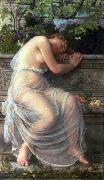 |
Edith Corbet
|
|
(28 December 1846 Goulburn, New South Wales - 1920 Hampstead), was a Victorian landscape painter, having close associations with the Macchiaioli group (also known as the Tuscans or Etruscans), who, in a break with tradition, painted outdoors in order to capture natural light effects and favoured a panoramic format for their paintings.
Edith was born in Goulburn, New South Wales, Australia, the second daughter and fifth child of Henry Edenborough and Margaret Stedman. The Edenborough family came from Leicestershire, but relocated to London, where they became prosperous merchants in hosiery and silk. Henry Edenborough was a sea captain and made several voyages to Australia between 1833 and 1837, deciding to settle there in 1840. He acquired a farm south of Goulburn known as 'Wollogorang' and built "a handsome two-storey brick and stone rubble building notable for its interesting French windows and its impressive outbuildings". This was the family home until 1854 when Henry and Margaret sold the property to John William Chisholm, and returned to England with their family of six children. Henry died in 1855 at Chesham Lodge in Surrey, aged 43. In 1861 the British census records show Edith, 14 years old, living with her widowed mother in Kensington. The 1871 census shows her living with her sister Annie, noted as head of household, at 5 Sheffield Gardens in Kensington, in which year she was exhibiting her work in London.
She married the painter Arthur Murch and moved to Rome where she painted with Giovanni Costa, leader of the Macchiaioli group. In 1876 they both stayed in Venice. Olivia Rossetti Agresti wrote: "Costa had a very high opinion of this artist's gifts and used to remember with pleasure how on that occasion they used to go out together to paint from nature at Fusino" (Agresti, 1904).
Edith Murch frequently exhibited from 1880 to 1890 at the Grosvenor Gallery and the New Gallery. In 1891 she married Matthew Ridley Corbet, one of the Macchiaioli group's leading members, after which she exhibited mainly at the Royal Academy, visiting Italy and living in London for the remainder of her life.
|
|
 |
Edmund Charles Tarbell
|
|
American Impressionist Painter, 1862-1938
American painter, illustrator and teacher. He attended drawing lessons at the Normal Art School, Boston, MA, and art classes with W. A. G. Claus. From 1877 to 1880 he was apprenticed to a lithographic company in Boston. In 1879 Tarbell entered the School of the Boston Museum of Fine Arts, where he was a pupil of Otto Grundmann (1844-90), a former student of Baron Hendrik Leys in Antwerp. In 1883 Tarbell left for Paris with his fellow student Frank W. Benson. Both Tarbell and Benson attended the Acad?mie Julian, where they studied with Gustave Boulanger and Jules Lefebvre. They travelled to Italy in 1884 and to Italy, Belgium, Germany and Brittany the following year. Tarbell returned to Boston in 1886. Initially after his return, Tarbell made a living from magazine illustration, teaching privately and painting portraits. In 1889 Tarbell and Benson took Grundmann's place at the Museum School. |
|
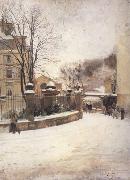 |
Edouard Castres
|
|
Swiss 1838 - 1902
Swiss painter. His father was a clock engraver, and he initially trained as an enamellist. He took drawing lessons from Barthelemy Menn and attended the Ecole des Beaux-Arts in Paris from 1859. He soon decided to concentrate on oil painting. He was assistant to the genre and figure painter Eduardo Zamacois y Zabala (1842-71). In the Franco-Prussian War he joined the Red Cross, moving into Switzerland at the beginning of February 1871 with the army led by Gen. Bourbaki. He painted military scenes from sketches carried out on the battlefield and received consistently good reviews, which also brought financial success. He was commissioned by a Belgian panorama company to record the entry of the French army into Switzerland, which he had witnessed in 1871. He spent the winter of 1876-7 on site at Les Verrieres, painting preparatory studies, and in 1881 he completed the panorama, Gen. Bourbaki's Army Retreating into Switzerland (Lucerne, Panorama). He was aided by nine assistants, recruited from among Menn's pupils, who included Ferdinand Hodler. The work was exhibited in Geneva and was brought to a rotunda in Lucerne in 1889. Among panorama paintings it is a work of a high order: despite the colossal dimensions and the barely comprehensible mass of people depicted, the dominant impression is of individual suffering. |
|
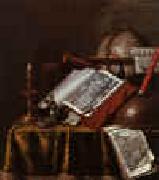 |
Edwaert Collier
|
|
Dutch
1640-1706
Evert Collier was born about 1640 in Breda, Noord-Brabant, and died in 1708. He is believed to have trained in Haarlem, as his earliest paintings show the influence of Pieter Claesz and Vincent Laurensz van der Vinne. By 1667, he had moved to Leiden, where he became a member of the Guild of St. Luke in 1673. He moved to Amsterdam by 1686 and to London in 1693. He was buried September 8, 1708 at St. James, Piccadilly.
The Denver Art Museum, the Honolulu Academy of Arts, the National Portrait Gallery (United Kingdom), the Rijksmuseum (Amsterdam) and the Tate (London) are among the public collections having paintings by Evert Collier. |
|
|
|
|
|
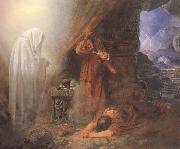 |
Edward Henry Corbould,RI,RWS
|
|
1815-1905
Painter, illustrator and sculptor, son of (2) Henry Corbould. A pupil of Henry Sass (1788-1844) and a student at the Royal Academy, he showed more wide-ranging interests than his father or uncle. He worked in watercolour and briefly in sculpture, winning gold medals for both from the Society of Arts (Fall of Phaeton, watercolour, 1834; St George and the Dragon, sculpture, exh. RA 1835; both untraced). He designed monumental figures for an unexecuted London County Council sculpture project for Blackfriars Bridge (1889), but he concentrated primarily on watercolours of literary and historical subjects, which he exhibited with the New Water-Colour Society from 1837 until 1898. |
|
|
|
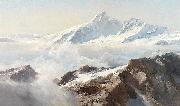 |
Edward Theodore Compton
|
|
(July 29 1849 - March 22 1921) was an English-born, German artist, illustrator and mountain climber. He is well-known for his paintings and drawings of alpine scenery, and as a mountaineer made 300 major ascents including no fewer than 27 first ascents.
Compton was born in Stoke Newington in London, the son of Theodore Compton, an art-loving insurance agent, and grew up in a deeply religious Quaker household. He attended various art schools, including, for a time, the Royal Academy in London, but otherwise he was mainly self-taught in art.
|
|
 |
Edward William Cooke
|
|
British Painter, 1811-1880
was an English painter and gardener. Cooke was born in London. His father George and uncle, William Bernard, were both well-known engravers and Cooke was raised in their wide artistic circle. He was a precocious draughtsman and a skilled engraver from an early age, displayed an equal preference for marine subjects and published his 'Shipping and Craft' C a series of accomplished engravings C when he was 18, in 1829. He benefited from the advice of many of his father's associates, notably Clarkson Stanfield (whose principal marine follower he became) and David Roberts. Cooke began painting in oils in 1833, took formal lessons from James Stark in 1834 and first exhibited at the Royal Academy and British Institution in 1835, by which time his style was essentially formed. He went on to travel and paint with great industry at home and abroad, indulging his love of the 17th-century Dutch marine artists with a visit to Holland in 1837. He returned regularly over the next 23 years, studying the effects of the coastal landscape and light, as well as the works of the country's Old Masters, resulting in highly successful paintings. These included 'Beaching a Pink at Scheveningen' (National Maritime Museum, London), which he exhibited in 1855 at the Royal Academy, of which he was an Associate from 1851. He went on to travel in Scandinavia, Spain, North Africa and, above all, to Venice.") Cooke was "particularly attracted by the Isle of Wight, and on his formative visit of 1835 he made a thorough study of its fishing boats and lobster pots; above all he delighted in the beaches strewn with rocks of various kinds, fishing tackle, breakwaters and small timber-propped jetties He also had serious natural history and geological interests, being a Fellow of the Linnean Society, Fellow of the Geological Society and Fellow of the Zoological Society, |
|
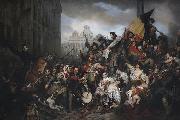 |
Egide Charles Gustave Wappers
|
|
(23 August 1803 Antwerp - 6 December 1874 Paris) is best known as the Belgian painter Gustave Wappers, while his oeuvre is also reckoned Flemish. He signed works by the name Gustaf Wappers.
He studied at the Royal Academy of Fine Arts in Antwerp, and during 1826 in Paris. The Romantic movement with its new ideas about art and politics was astir in France. Wappers was the first Belgian artist to take advantage of this state of affairs, and his first painting, "The Devotion of the Burgomaster of Leiden," appeared at the appropriate moment and had marvellous success in the Brussels Salon during 1830, the year of the Belgian Revolution. While political, this remarkable work revolutionized the direction of Flemish painters.
Episode of the Belgian Revolution of 1830 (1834), Museum of Ancient Art, Brussels.Wappers was invited to the court at Brussels, and was favoured with commissions. In 1832 the city of Antwerp appointed him Professor of Painting. He exhibited his masterpiece, "Episode of the Belgian Revolution of 1830" or rather "Episode of the September Days of 1830 on the Grand Place of Brussels", (Museum of Ancient Art, Brussels) at the Antwerp Salon in 1834. He was subsequently appointed painter to Leopold, King of the Belgians. At the death of Matthieu-Ignace Van Bree in 1839 he was elavated to director of the Antwerp Academy. One of his pupils was Ford Madox Brown; another was the Czech history painter Karel Javůrek.
His works are numerous; some of them in traditional devotional modes ("Christ Entombed"), while others illustrate the Romantic view of history: "Charles I taking leave of his Children", "Charles IX", "Camoens", "Peter the Great at Saardam", and "Boccaccio at the Court of Joanna of Naples".
Louis Philippe gave him a commission to paint a large painting for the gallery at Versailles, "The Defence of Rhodes by the Knights of St John of Jerusalem". He finished the work in 1844, the same year that he received the title of baron from Leopold I.After retiring as director of the Antwerp Academy, he settled in 1853 in Paris, where he died in 1873 - having been one of the most talented flagships of Romanticism in Belgium.
|
|
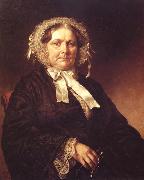 |
Elliott Charles Loring
|
|
born in Scipio, New York, in December 1812; died in Albany, NY., 25 Sept., 1868.
died in Albany, NY., 25 Sept., 1868., American painter. Resolved to become an artist, he moved from Syracuse, NY, to New York City around 1830, bearing a letter of introduction to John Trumbull and reportedly receiving some brief instruction from him. Elliott spent six months in the studio of the genre painter John Quidor but returned to upstate New York, where he worked for several years as an itinerant portrait painter. Back in New York City by 1839, his art steadily improved; Henry Inman met him around 1844-5, whereupon he predicted: 'When I am gone that young man will take my place'. Elliott's portrait of Capt. John Ericsson (c. 1845; untraced) won praise in 1845 as 'the best American portrait since [Gilbert] Stuart', and from that date he was acknowledged as New York's leading portrait painter. His facility for capturing a vivid, characteristic likeness and his genial personality assured a constant stream of private patrons and public commissions. In 1867 it was reported that he had executed nearly 700 portraits. |
|
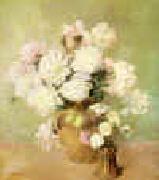 |
Emil Carlsen
|
|
Danish-born American Painter, 1853-1932
Soren Emil Carlsen (1853 ?C 1932) was an American painter associated with the Cos Cob Art Colony.
Carlsen painted primarily landscapes and still lifes. His fastidiously painted still lifes are influenced by Chardin and often depict copper pans, game, or flowers. He was an art teacher for over fifty years; his students included James Swinnerton. |
|
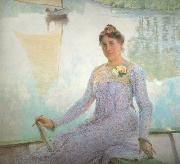 |
Emile Claus
|
|
Belgian Painter, 1849-1924
Belgian painter. He had various menial jobs before the composer Peter Benoet persuaded his father to let him study at the Koninklijke Academie voor Schone Kunsten in Antwerp. He was taught there by Nicaise De Keyser and Jacob Jacobs (1812-79) but found the atmosphere uncongenial and soon left. In 1879 he travelled around Spain and North Africa and in 1881 went to live with his sister at Waereghem. His painting of this period was influenced by Charles Verlat and depicted rural subjects |
|
 |
Emily Carr
|
|
Canadian Expressionist Painter, 1871-1945
Canadian painter and writer. She studied art from 1891 to 1894 at the California School of Design in San Francisco. She lived in England from 1899 to 1904, studying at the Westminster School of Art in 1899, and settled in Vancouver on her return. Her stay in Paris in 1910-11, during which she had a painting shown at the Salon d'Automne in 1911, proved far more influential on her art, familiarizing her with Impressionism, with Post-Impressionism and with Fauvism. |
|
|
|
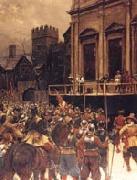 |
Ernest Crofts
|
|
English Painter , b. 15 September 1847- d. 19 March 1911
was an English painter who specialized in battle scenes. Ernest Crofts, RA lived at 'The Green' which he helped to re-design, next to Blythburgh church in Suffolk. |
|
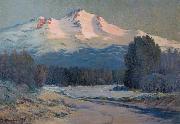 |
Ernst William Christmas
|
|
(1863-1918) was an Australian painter. He was born near Adelaide, South Australia in 1863 and studied art in Adelaide, Sydney and in London. He painted widely in England, exhibiting in the early years of the century at the Royal Academy, the Royal Institute of Oil Painters, the Royal Society of British Artists, the Royal Glasgow Institute of Fine Arts and in the provinces.
He was elected to the British Royal British Academy in 1909. In 1910-11, he painted mountains and lakes in Argentina and Chile. He lived in San Francisco around 1900 and again around 1915. He was an avid traveller, but spent the last two years of his life in Hawaii, where he painted landscapes including dramatic volcano scenes. Ernest William Christmas died in Honolulu in 1918.
|
|
|
|
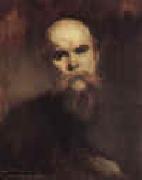 |
Eugene Carriere
|
|
French Symbolist Painter, 1849-1906
French painter and lithographer. He is best known for his spiritual interpretations of maternity and family life. Characteristic are his Crucifixion and Maternity (both: Louvre). He also painted some large canvases for the Sorbonne and the Hôtel de Ville, Paris. Among his works are many notable portraits, including those of Verlaine, Daudet, and Edmond de Goncourt. |
|
|
|
|
|
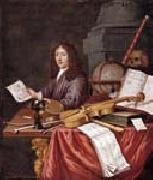 |
Evert Collier
|
|
(c. 1640 - few days before September 8, 1708) was a Dutch painter known for vanitas still-life and trompe l'oeil paintings. His first name is sometimes spelled "Edward" or "Edwaert" or "Eduwaert" or "Edwart," and his last name is sometimes spelled "Colyer" or "Kollier".
Evert Collier was born between 1630 and 1650 in Breda, Noord-Brabant, and died in 1708. He is believed to have trained in Haarlem, as his earliest paintings show the influence of Pieter Claesz and Vincent Laurensz van der Vinne. By 1667, he had moved to Leiden, where he became a member of the Guild of St. Luke in 1673. He moved to Amsterdam by 1686 and to London in 1693. He was buried September 8, 1708 at St. James's, Piccadilly. |
|
 |
Eyre Crowe
|
|
Sir Eyre Alexander Barby Wichart Crowe GCB GCMG (30 July 1864 - 28 April 1925) was a British diplomat. Crowe was appointed Companion of the Order of the Bath (CB) in 1907, Knight Commander of the Order of St Michael and St George (KCMG) in 1911, Knight Commander of the Order of the Bath (KCB) in 1917, Knight Grand Cross of the Order of St Michael and St George (GCMG) in the 1920 New Year Honours,[1] and Knight Grand Cross of the Order of the Bath (GCB) in the 1923 Birthday Honours.
Eyre Crowe was born in Leipzig and educated at Desseldorf and Berlin and in France, with a German mother and a German wife. His father Joseph Archer Crowe had been a British consul-general and ended his career as commercial attache for all of Europe (1882-1896). His grandfather Eyre Evans Crowe was a journalist, writer and historian, and his uncle, Eyre Crowe, was an artist.
Crowe first visited England in 1882 when he was seventeen to cram for the Foreign Office examination and at the time was not fully fluent in English.[2] Even later in life it was reported that when angry he spoke English with a German accent. He married his widowed German cousin Clema Gerhardt in 1903. Crowe's wife's uncle was Henning von Holzendorff, who was to become the Chief of the German Naval Staff in the First World War. Due to being half-German, Crowe was often attacked in the press and by Christabel Pankhurst and William le Queux for this during the First World War.
|
|
|
|
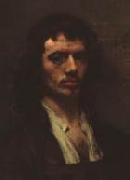 |
FABRITIUS, Carel
|
|
Dutch Baroque Era Painter, 1622-1654
Painter. His oeuvre consists of a scant dozen paintings, since research has rigorously discounted many previously attributed works. These few paintings, however, document the painter's unique development within his brief 12-year career. He is often mentioned as being the link between Rembrandt and the Delft school, particularly Pieter de Hooch and Jan Vermeer, whose depiction of light owes much to Fabritius's late works in which his use of cool silvery colours to define forms in space marks a radical departure |
|
|
|
|
|
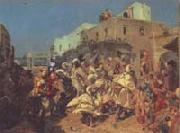 |
Fernand cormon
|
|
French Academic Painter, 1845-1924
French painter. He studied initially in Brussels under Jean-Fran?ois Portaels. In 1863 he returned to Paris, where for three years he was a pupil of Alexandre Cabanel and Eug?ne Fromentin. He made his d?but at the Salon in 1868 and in 1870 received a medal for the Marriage of the Niebelungen (1870; ex-Mus. B.-A., Lisieux, 1970). His painting the Death of King Ravana (1875; Toulouse, Mus. Augustins), taken from the Indian epic poem the Ramayana, was criticized for the choice of an obscure subject but was nevertheless awarded the Prix de Salon in 1875. Soon afterwards Cormon left France for Tunisia. After his return in 1877 he exhibited regularly at the Salon until his death, establishing a reputation as a painter of historical and religious subjects; he also produced some portraits. |
|
|
|
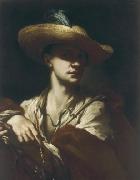 |
Francesco Caccianiga
|
|
Francesco Caccianiga (1700-1781) was an Italian painter and engraver.
He was born in Milan. In Bologna, he became a pupil of Marcantonio Franceschini. He afterwards visited Rome, where he established himself under the patronage of Prince Borghese, for whom he executed some considerable works in the Palazzo and the Villa Borghese. His principal works are at Ancona, where he painted several altar-pieces, among them, Marriage of the Virgin and Last Supper. |
|
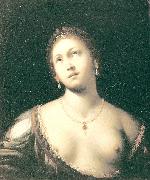 |
Francesco Cairo
|
|
(1607-1665) was an Italian painter active in Baroque Lombardy and Piedmont.
He was born and died in Milan. It is not known where he obtained his early training though he is strongly influenced by the circle of il Morazzone, in works such as the Saint Teresa altarpiece in the Certosa di Pavia.
In 1633, Cairo moved to Turin to work as a court painter, including portraits, to Vittorio Amedeo I of the House of Savoy. Between 1637-1638, Cairo travelled to Rome, where he encounters the works of Pietro da Cortona, Guido Reni and of the Caravaggisti. He returns to Lombardy to complete altarpieces for the Certosa of Pavia and a church at Casalpusterlengo. He painted a St. Theresa for San Carlo in Venice. Between 1646-1649, he returns to Turin, and paints an altarpiece for Savigliano and the church of San Salvario. He is also known as Il Cavaliere del Cairo, because in Turin, he received the order of SS. Lazarus and Maurice in recognition of his merit.
Many of his works are eccentric depictions of religious ecstasies; the saints appear liquefied and contorted by piety. He often caps them with exuberant, oriental turbans. |
|
|
|
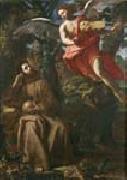 |
Francesco Cozza
|
|
1605-1682)was an Italian painter of the Baroque period.
He was born in Stilo in Calabria and died in Rome. As a young man, he went to Rome and apprenticed with Domenichino. He traveled with Domenichino to Naples.
He is best known for his expansive panegyric ceiling fresco, Apotheosis of Pamphili House, in the library of Palazzo Pamphili in Piazza Navona (1667-73). He also frescoed the Stanza del Fuoco in Palazzo Pamphili in Valmontone, 1658-59), where he worked along with Pier Francesco Mola, Gaspar Dughet, Mattia Preti, Giovanni Battista Tassi (il Cortonese), and Guglielmo Cortese. He also participated with Carlo Maratta and Domenico Maria Canuti in fresco decorations of the Palazzo Altieri. His landscape paintings recall the Carracci style of paesi con figure piccole (landscapes with small figures). He painted a Madonna del Riscatto in church of Santa Francesca Romana. He was received into the Accademia di San Luca at Rome in 1650. |
|
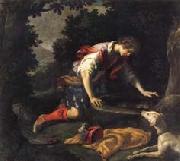 |
Francesco Curradi
|
|
Italian Baroque Era Painter, 1570-1661
son of Taddeo Curradi. He produced many devotional works and had a large clientele. At their best, the works are distinguished by lucid draughtsmanship, simple compositions and elegant, melancholy figures. Curradi was trained in the studio of Giovan Battista Naldini and in 1590 matriculated from the Accademia del Disegno, Florence. His first independent works include a Virgin and Child with Saints (1597; Volterra, S Lino) and a Birth of the Virgin (1598; Volterra Cathedral), both signed and dated. These paintings reflect the new clarity and directness introduced into Florentine painting by such artists as Santi di Tito and Jacopo Ligozzi. Subsequent works include a Crucifixion (1600) and a Virgin and Saints (1602; both Legnaia, S Angelo). In these the influence of Naldini yielded to that of Lodovico Cigoli and his circle, while the mildness of expression in the figures was inspired by Domenico Passignano. An album of 87 red chalk drawings, with scenes from the Life of St Mary Magdalene dei Pazzi (1606; Florence, convent of the Carmelites at Careggi) distinguished by their precision and clear, characteristically Florentine compositions, contributed to the iconography of this popular Counter-Reformation saint. In 1607 Curradi was commissioned to portray her mortal remains, and this painting, together with the drawings, |
|
|
|
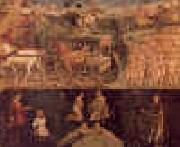 |
Francesco del Cossa
|
|
Italian
c1435-c1478
Francesco del Cossa Location
Italian painter. He was a leading representative of the Ferrarese school and was regarded, with Ercole de Roberti, as the founder of the Bolognese school. His principal works include The Glorification of March, April, and May, frescoes in the Schifanoia Palace, Ferrara; some admirable portraits of the artist contemporaries; Madonna Enthroned (Bologna); Madonna and Child with Angels, St. Liberal, and St. Lucy (National Gall. of Art, Washington, D.C.); and an altarpiece representing scenes from the life of St. Vincent Ferrer (National Gall., London, and the Vatican). |
|
|
|
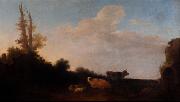 |
Francesco Giuseppe Casanova
|
|
(1727-1803) was an Italian painter and a younger brother of Giacomo Casanova.
Francesco Casanova Battaglia di cavalleria (oil on canvas, Louvre, Paris)Born in London, he trained in Venice under Francesco Guardi, then was a pupil of Francesco Simonini, a battle painter who took Borgognone as his model. Besides battle-pieces Casanova painted landscapes with figures and cattle, as well as pastoral subjects. He arrived in Paris in 1751, and went to Dresden in the following year, where he remained until 1757, spending his time in copying the finest battle-pieces of the famous Electoral Gallery. On his return to Paris he studied for a time under Charles Parrocel, and was received into the Academy in 1763. He exhibited at the Salon at intervals from that year till 1783, when he again quit France, going to Vienna, where he resided during the remainder of his life. Philip James de Loutherbourg was his pupil for a time.
|
|
|
|
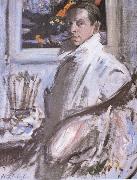 |
Francis Campbell Boileau Cadell
|
|
Scottish, 1883-1937, was a Scottish painter associated with the Scottish Colourists. Francis Cadell was born in Edinburgh and, from the age of 16, studied in Paris at the Academie Julian, where he was in contact with the French avant-garde of the day. While in France, his exposure to work by the early Fauvists, and in particular Matisse, proved to be his most lasting influence. After his return to Scotland, he was a regular exhibitor in Edinburgh and Glasgow, as well as in London. He painted landscapes, interiors, still life and figures in both oil and watercolour, but he is particularly noted for his portraits, depicting his subject with vibrant waves of colour. He enjoyed the landscape of Iona enormously, which he first visited in 1912 and features prominently in his work. |
|
|
|
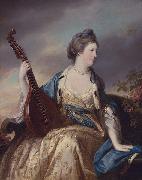 |
Francis Cotes
|
|
(20 May 1726 - 16 July 1770) was an English painter, one of the pioneers of English pastel painting, and a founder member of the Royal Academy in 1768.
He was born in London, the eldest son of Robert Cotes, an apothecary (Francis's younger brother Samuel Cotes (1734 - 1818) also became an artist, specialising in miniatures). Cotes trained with portrait painter George Knapton (1698 - 1778) before setting up his own business in his father's business premises in London's Cork Streetelearning, incidentally, much about chemistry to inform his making of pastels.
An admirer of the pastel drawings of Rosalba Carriera, Cotes concentrated on works in pastel and crayon (some of which became well-known as engravings). After pushing crayon to its limit as a mediumealthough he was never to abandon it entirelye - otes turned to oil painting as a means of developing his style in larger-scale works. In his most successful paintings, particularly those of the early 1760s, the oil paint is thinly applied, in imitation of his pastel technique, and imbued with charm, inviting comparisons with Allan Ramsay (1713 - 1784) and Sir Joshua Reynolds. They have clarity and warmth and possess a remarkable attention to costume. In 1763, he bought a large house (later occupied by George Romney) in Cavendish Square.
One of the most fashionable portrait painters of his day, Cotes helped found the Society of Artists and became its director in 1765. At the peak of his powers, Cotes was invited to become one of the first members of the Royal Academy, but died just two years later, aged 44, in Richmond.
He also taught pastel skills to John Russell, and his skills were described in book The Elements of Painting with Crayon.
|
|
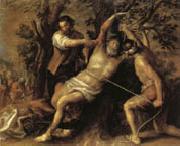 |
Francisco Camilo
|
|
Spanish painter (b. 1615, Madrid, d. 1673, Madrid)
was an Italian painter of the Renaissance period. He was born at Bassano del Grappa near Venice, the eldest son of Jacopo Bassano and grandson of Francesco da Ponte the Elder. He studied with his father and worked in the Bassano family workshop along with his three brothers, including Giambattista and Girolamo. He moved to Venice where he ran the branch of the family business, and where he was employed to paint a series of historical pictures in the Doge's Palace, but prone to hypochondria and other ailments, committed suicide by throwing self-defenestration soon after his father's death in 1592. |
|
|

